________________
SOCIAL LIFE
167
certain circumstances. Remarriage was thus prevalent amongst the lower castes where it might have been an economic necessityl and was also not considerd as a factor degrading the family prestige.
Niyoga or Levirate-The practice of Niyoga or Levirate was quite prevalent in ancient India. This practice allowed a childless woman to have a son through any other person in case the husband was dead or was incapable of procreating children. In the NC. we find that an heirless king is advised by his ministers to have a son through monks in order to save the kingdom from destruction. It was believed : “The seed in the field could be sown by any one but its product belonged to the landlord. Similarly, the son born to a wife belonged to her husband alone”. However, even in exceptional circumstances the rulers tried to avoid this practice because of the fear of social repercussions. Levirate as a social practice has been severely condemned as a “beastly practice'' by the contemporary law-givers and was out of vogue soon after the sixth century A.D.
Satī or Self-immolation--The custom of Satī or self-immolation was common during these conturies,5 as it has been referred to by most of the law-givers of the time. Contemporary inscriptions also refer to this practice.' A story in the NC. narrates that 500 merchants of Sopāraya were ordered by the king to be burnt alive due to non-payment of taxes. Their wives also voluntarily entered the burning pyre after their
1. Majumdar, op. cit., p. 156. 2. Höflfé fotef=31 aya hil feces, Qc a TITA JE à --NC. 2, p. 381;
also NC. 1, p. 127. 3. जहा परखेत्ते अण्णेण बीयं वाविय खेत्तिणो आहव्वं भवति, एवं तुह अंतेउरखेत्ते अण्णेण
are POAST TE a g raf-NC. 1, p. 127. 4. Altekar, op. cit, pp. 168-75. 5. For the custom of Satī see-Altekar, op. cit., pp. 143-48. 6. Ibid. 7. See-Eran Posthumous Pillar Inscription of Goparāja” (A. D. 510-14)
--CII. III, No 20, p. 93, also No. 2, p. 92.
Jain Education International
For Private & Personal Use Only
www.jainelibrary.org




